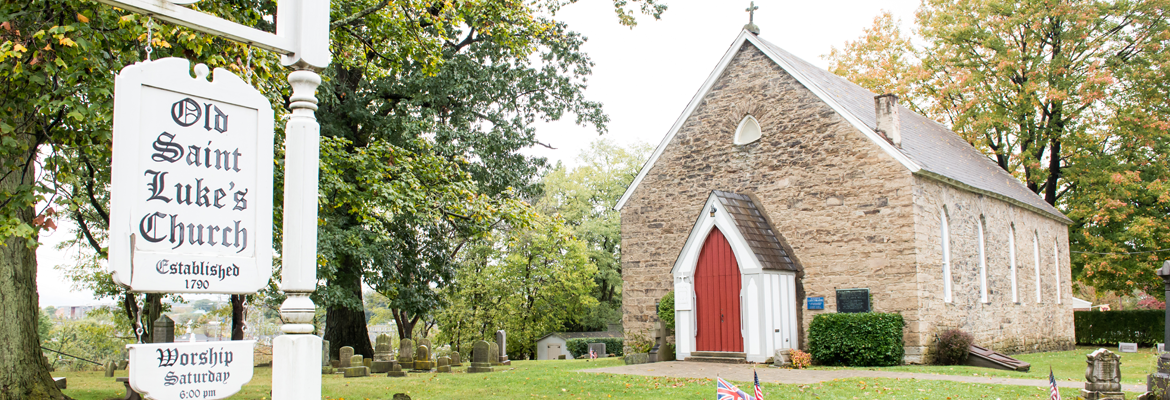(Old) St. Luke’s and the Whiskey Rebellion
Just after George Washington was inaugurated President of the United States, Major William Lea and Gen. John Neville constructed the first St. Luke’s Church in 1790. The President asked Alexander Hamilton to design an excise tax on distilled spirits to help pay the debts from the Revolutionary War. Farmers west of the Appalachian Mountains distilled whiskey and all of them resented the tax. Washington named Gen. Neville as the tax collector in southwestern Pennsylvania. In July, 1794, farmers from four counties of this area attacked Neville and burned his mansion. Washington responded, first, with negotiation, and then by leading 13,000 militiamen into the area to end the violence. Peace was obtained by February, 1795. The Whiskey Rebellion was the first test of the United Sates Constitution and the authority of the President, which Abraham Lincoln also used in the Civil War.
An Outline of the 1794 Whiskey Rebellion
A first task for the newly inaugurated President George Washington was to unite thirteen colonies and form the United States of America. An important way of doing that was to combine all of the Revolutionary War debts of the colonies, and find enough money to fund the new government.
The President named Alexander Hamilton to be his first Secretary of the Treasury. In 1791, Hamilton advanced a plan for an excise tax placed on distilled spirits. Since almost all settlers and farmers west of the Appalachian Mountains distilled whiskey from their crops, they immediately resented paying this tax and most of them refused to pay it
Washington had to obtain compliance with the tax somewhere. His longtime friend and wartime compatriot, Brig. General John Neville in Pittsburgh, was called upon to be the Inspector of Revenue, or tax collector, in southwestern Pennsylvania. Surely Neville could demonstrate compliance.
Neville was the wealthiest resident in southwestern Pennsylvania, and local and struggling farmers resented both Neville’s status and Hamilton’s tax. He was a member of (Old) St. Luke’s Church.
In July 15, 1794, Neville and a Federal marshal pressed farmer William Miller to pay the tax or face arrest. The Miller’s workers chased them off the farm. The next day, July 16, 35 farmers went to Neville’s residence, called Bower Hill on the hill above the Chartiers Creek, to demand his resignation and all records destroyed. Young Oliver Miller was mortally wounded. We believe Neville sought safety in his family’s nearby (Old) St. Luke’s Church.
On July 17, some 500 irate farmers stormed Bower Hill, again making their demands the leader of the farmers, Capt James MacFarlane, was killed. The farmers torched Bower Hill property. Neville communicated the violence and loss of his home to the President.
On August 1, farmers met at Braddock and they declared a state of rebellion. Washington ordered peace on August 7 and he sent a peace commission to negotiate. They met at Parkinson’s Ferry (today’s Monongahela, Pa.) On August 28 in Brownsville, a vote was taken and the President’s order was rejected by a vote of 3 to1.
In September Washington recruited about 13,000 militiamen from the east coast to subdue the anti-federalists and to prevent any further violence. In October 28, the troops, who were led by Washington as far as Bedford, arrived in the area and some went to Uniontown and some went to Pittsburgh. Some farmers even threatened to burn down Pittsburgh. Gen. “Light Horse” Harry Lee was placed in charge of the troops to restrain the farmers through the oncoming winter. Washington declared the rebellion to be over in February. The Whiskey Rebellion was the first test of the new Constitution of the United States. Washington’s call to the militia was the precedent that President Lincoln followed when he called out the army in the Civil War.
Read more from the Archive:
Incidents of the Insurrection, by Hugh Henry Brackenridge
Newsmaker Light Horse Harry Lee by Richard Davies
Light Horse Harry Lee and Washington County by Richard Davies
Whiskey Rebellion Flags by Richard R Gideon.
Take the Whiskey Rebellion Quiz – Click HERE.

